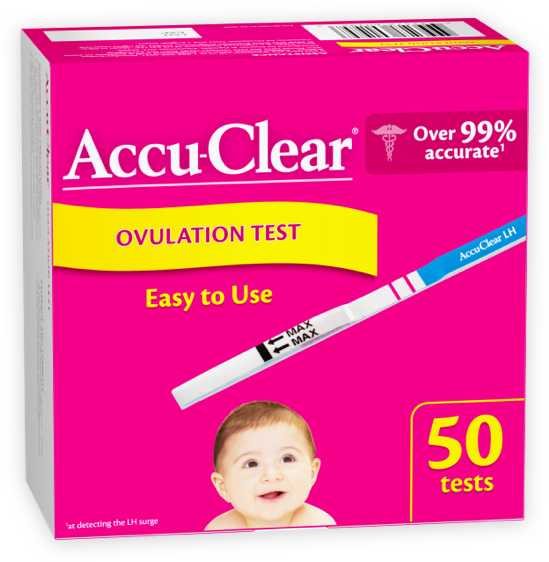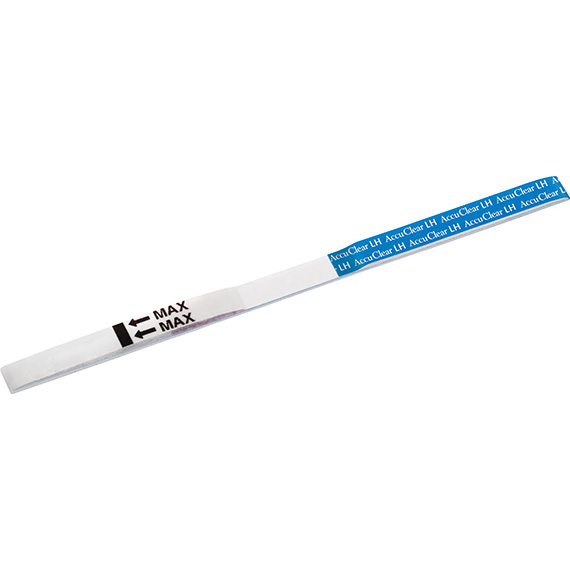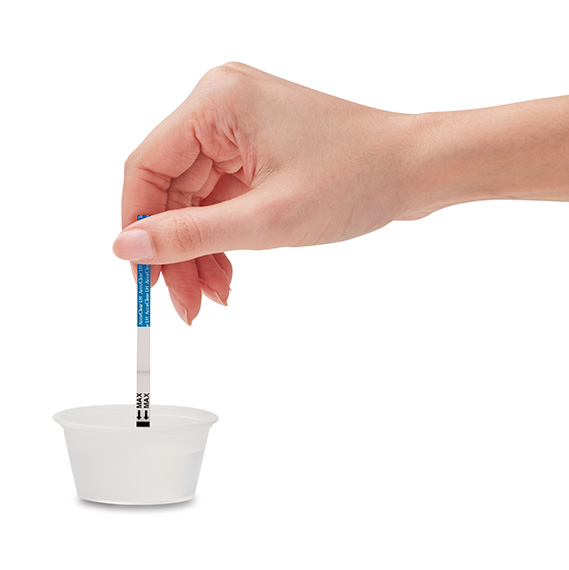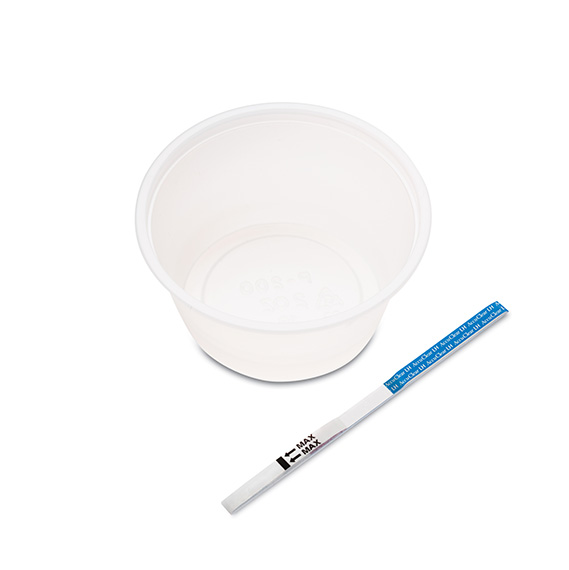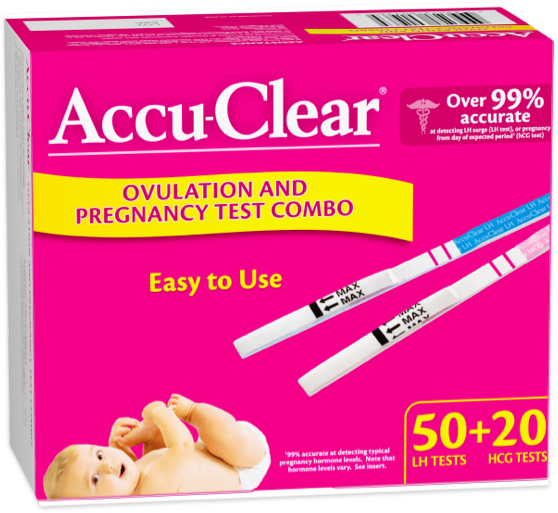Accu-Clear® Ovulation Test
Over 99% accurate at detecting LH surge
Ovulation Test Strips
When you are trying to get pregnant, timing makes all the difference. There are only a few days in your cycle when you can get pregnant, which is why if you’re trying for a baby knowing these days is important so that you can have sex on the best days to help you conceive. An ovulation test works by detecting luteinizing hormone (LH), which surges just before you release an egg – called ovulation. Using an ovulation test can help you get pregnant by identifying your most fertile days that cycle.

Instructions
Before you begin
• Always read the instructions on the leaflet carefully before testing.
• The unopened test can be stored at room temperature (up to 30°C/86°F). Do not freeze.
• Do not open foil pouch until sample is collected and you are ready to start the test.
• Do not use if the foil pouch is torn or not sealed.
• Do not use if the test is past the expiry date.
• Do not drink too much water or other beverages before testing.
Contents of the test kit
This test kit contains 50 pouches. Each pouch contains one test and a desiccant. Note: The desiccant is for storage purposes only and is not used in the test procedure.
What else you need
1. A timer (watch or clock)
2. A clean, dry container to collect your urine sample.
Sample collection and preparation
1. The best time to collect urine is between 10am and 8pm. For the best results, try to collect urine at approximately the same time each day.
2. First morning urine is not recommended, but any other time of day is suitable.
3. Refer to WHEN TO START CHART to determine the day to start testing.

How to collect urine
1. Collect your urine sample in a clean, dry plastic or glass container.
2. Do not mix urine samples collected at different times.
3. The urine does not require any special pre-treatment.
How to do the test
1. Collect a urine sample in a dry and clean plastic or glass container.
2. Remove the test from the pouch and use it as soon as possible. Avoid touching any part of the test other than the blue handle.
3. Point the test in the direction of the arrows and dip it into the urine sample, making sure the test is not submerged past the MAX line.
4. Hold the test vertically in the sample for at least 10-15 seconds.
5. Remove the test from the sample and lay it flat on a dry, clean, and non-absorbent surface.
6. Read the result between 10 and 20 minutes after sampling.
How to read the result
After you take a test, you should see the control line (C) close to the blue handle. This tells you that the test worked. If your LH surge has been detected, then you will see another line, the test line (T), that’s equal to the control line in intensity or darker. When you get a positive result, this is a good time to have sex to maximize your chances of getting pregnant.
If you only see a C line or a T line that’s fainter than the C line, then your LH surge has not been detected. When you get a negative result, continue daily testing until you get a positive result.
If you do not see the C line, then the test is invalid. Use another test if the test is invalid.
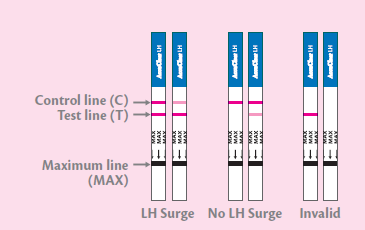
Product benefits
Over 99% accurate at detecting the LH surge
Identifies your 2 most fertile days
Since the LH surge occurs approximately 24-36 hours before you ovulate (when you release an egg from your ovary), an ovulation test identifies your 2 most fertile days. You are at your most fertile on the day the test detects the LH surge and the day after, which makes it the best time to have sex to maximize your chances of getting pregnant.
Over 99% accurate
Accu-Clear® Ovulation Tests are over 99% accurate at detecting the LH surge.
Easy to use
Just collect a urine sample and using the arrows to guide you, dip the test in the sample for 10-15 seconds. Then lay the test flat and read the results 10-20 minutes after taking the test.
50 TESTS IN ONE TEST KIT
The Accu-Clear® Ovulation Test comes with 50 LH tests in one kit. Start testing based on your cycle length (details in the instruction leaflet) and keep testing for at least 5 days, or until you detect your LH surge. With 50 LH tests you’ll have enough strips to keep testing in your next cycle if you don’t become pregnant.
FAQs
How does the Accu-Clear® Ovulation Test work?
Just before an egg is released from your ovary, there is an increase in LH, which can be detected in your urine. Accu-Clear® Ovulation Test works by detecting the surge in LH in your urine. The LH surge occurs approximately 24-36 hours prior to ovulation. You are at your most fertile on the day your LH surge is detected and the day after.
When can I test with Accu-Clear® Ovulation Test?
This depends on when you had your last period and your cycle length. If the length of your cycles each month only differ by a few days, then you can take the average number of days from the past three months. If your cycle is more irregular, then you may want to use your shortest cycle length when reading the chart. Use the ‘WHEN TO START CHART’ above, on the side of the box, or in the leaflet to work out when to start testing. Count from the first day of your period and test on the recommended day.
IF I GET A POSITIVE RESULT, WHAT DO I NEED TO DO?
This means the test has detected your LH surge, which means you are likely to ovulate within the next 24-36 hours. A positive result means you are at your most fertile time and having sex today and tomorrow improves your chances of getting pregnant.
IF THE RESULT IS NEGATIVE, WHAT DO I NEED TO DO?
This indicates that no LH surge has been detected and you should continue daily testing.
WHAT IF I DON’T DETECT AN LH SURGE? WHY DOES THIS HAPPEN?
It is possible that you may not see a positive result in a given cycle.
There are a few reasons for this:
1. Your LH surge may be too low for the test to detect it.
2. You may not have ovulated this cycle.
3. If you miss a test, you may not see your LH surge, so remember to test as advised.
Keep testing into the next cycle, but if you don’t see an LH surge for 3 consecutive cycles, consult your healthcare provider.
IS THERE ANYTHING THAT CAN AFFECT RESULTS?
Yes, medication containing hCG or LH may affect the result and should not be taken while using this ovulation test. It’s also possible your result may be affected during or after:
• pregnancy
• the onset of menopause
• using birth control pills
However, the results should not affected by:
• alcohol
• pain relievers
• antibiotics
• other common drugs
If you are taking medication, or get unexpected results, you should consult your healthcare provider.
HOW DO I KNOW THE TEST WORKED?
If you see the control line (C), this tells you that the test worked correctly.
HOW LONG DOES THE RESULT LAST?
You’ll need to wait for the full reaction time of 10-20 minutes to confirm a negative result. If you get a positive result, this will not change after the test has completed, but to avoid getting any incorrect results, you should not read after 30 minutes.
I HAVE BEEN HAVING SEX AFTER GETTING A POSITIVE RESULT, AND I AM STILL NOT PREGNANT, WHY IS THIS?
There are many factors that can affect your ability to get pregnant even if you get the timing right.
We recommend seeing a healthcare provider if:
• You are under 35 years old and have been trying to get pregnant for a year (12 months) without any success.
• You are 35 years old or over and have been trying to get pregnant for 6 months without success.
• You are over 40.
I THINK I MIGHT BE PREGNANT. WHAT CAN I DO?
We recommend taking a pregnancy test—like our Accu-Clear® Pregnancy Test Strips — if you think you might be pregnant. If you are pregnant, then see your healthcare provider to get advice about what steps to take.
DO I NEED AN OVULATION TEST IF I AM DOING BBT?
When you measure basal body temperature (BBT), you only see the rise in temperature after you have ovulated. An ovulation test tells you when you are about to ovulate, so you can have sex to maximize your chances of getting pregnant.
WHAT HAPPENS IF I DRINK TOO MUCH LIQUID BEFORE TESTING?
Drinking an excessive amount of liquid before testing may dilute the quantities of LH present in your urine. We recommend you limit the amount you drink for about 2 hours before you collect your urine for testing.
HOW LONG SHOULD I CONTINUE TO TEST?
Keep doing the tests for at least 5 days or until the LH surge has been detected.
DO I NEED TO USE ALL THE TESTS?
No, you can stop testing when you get a positive result and keep the rest of the tests for your next cycle if you need them.
